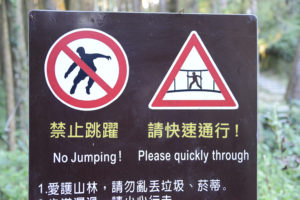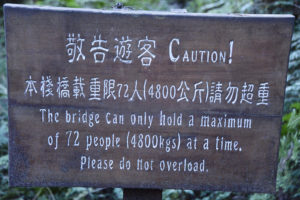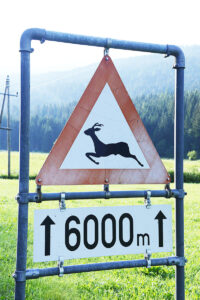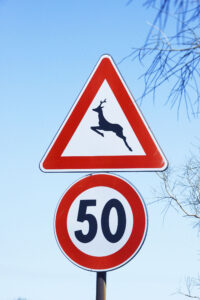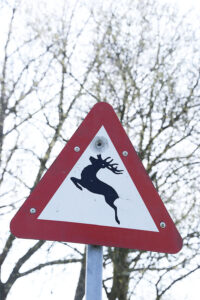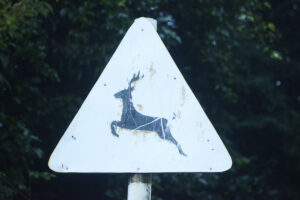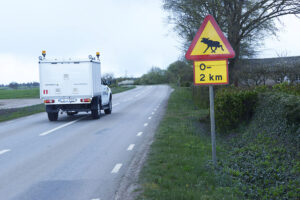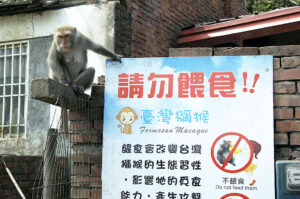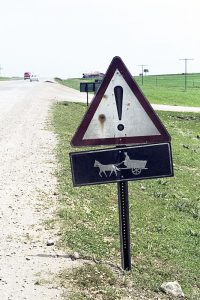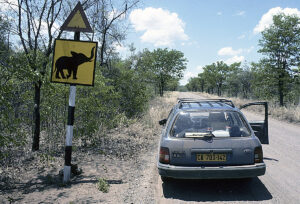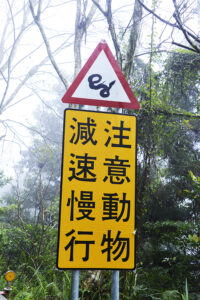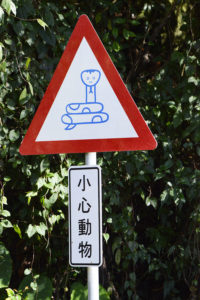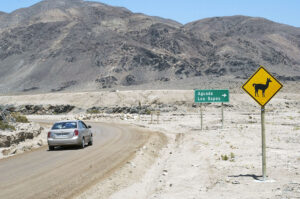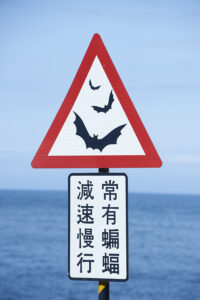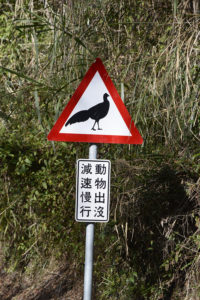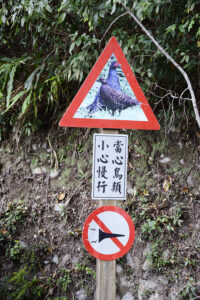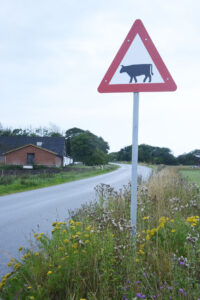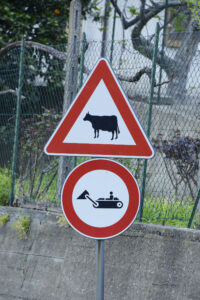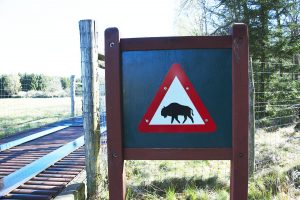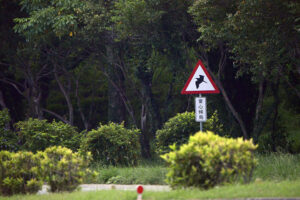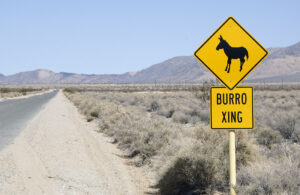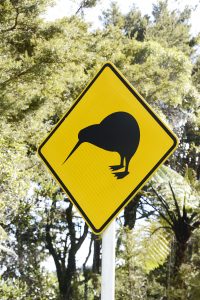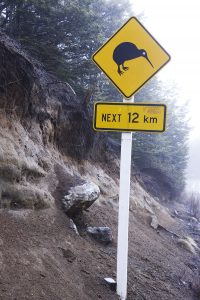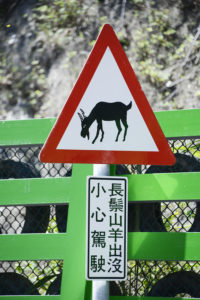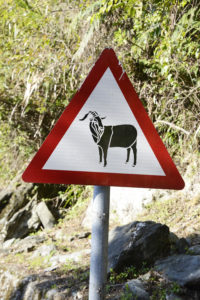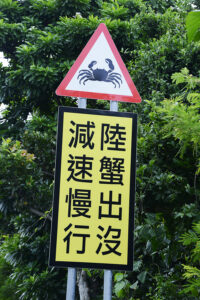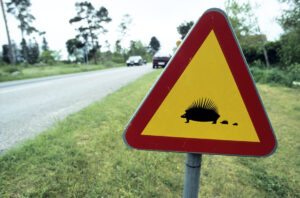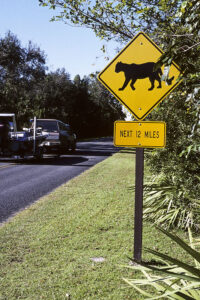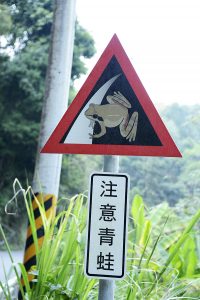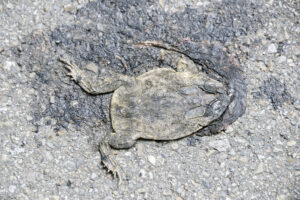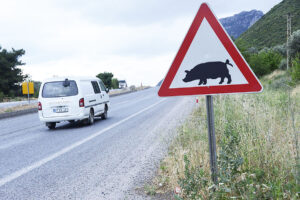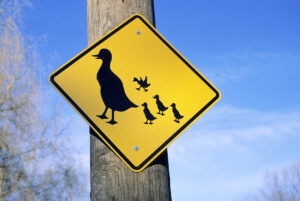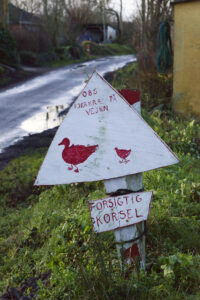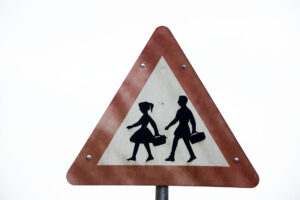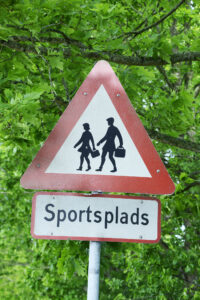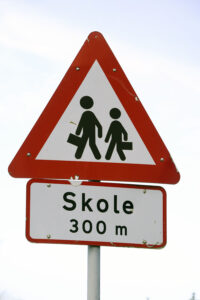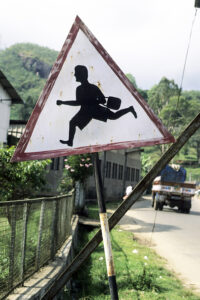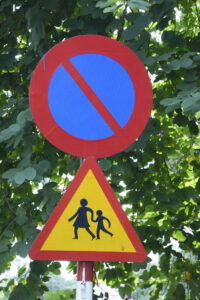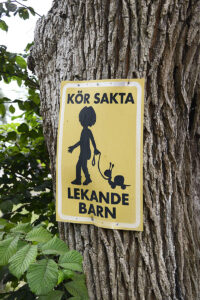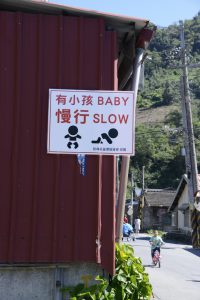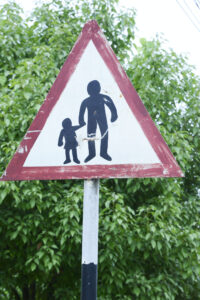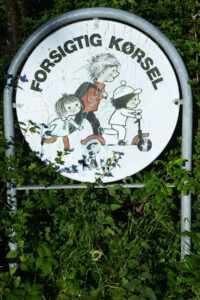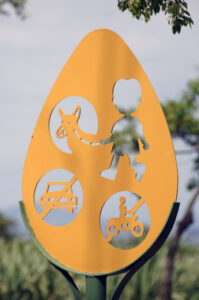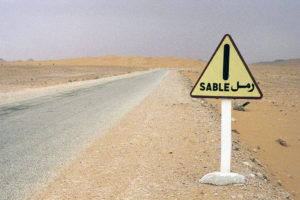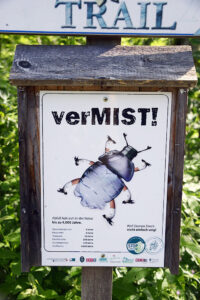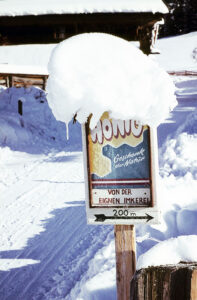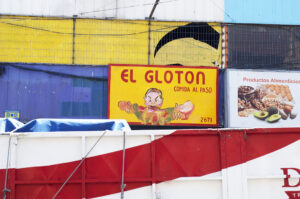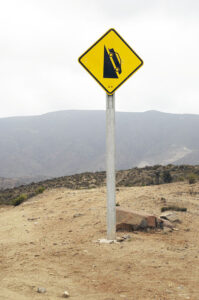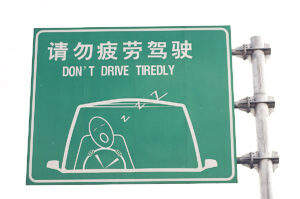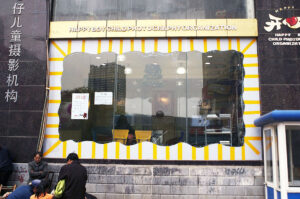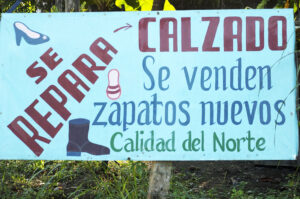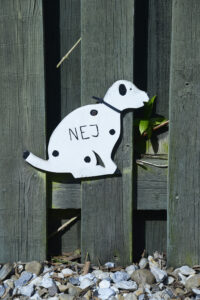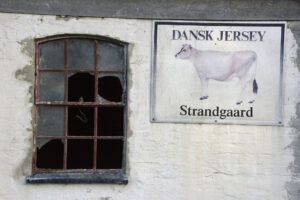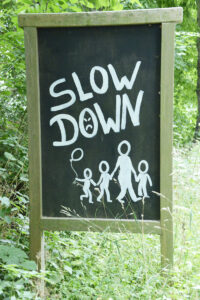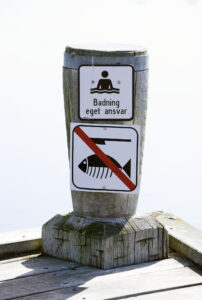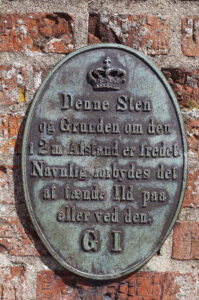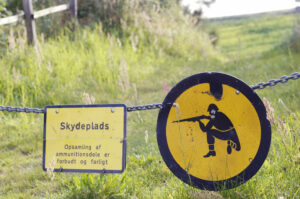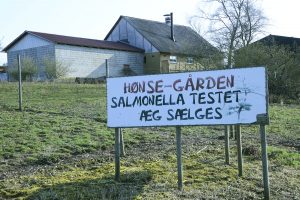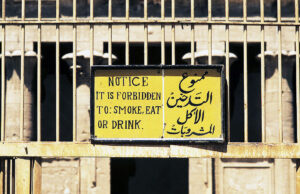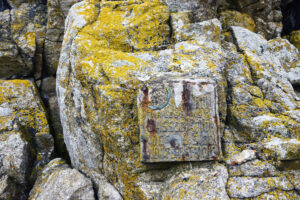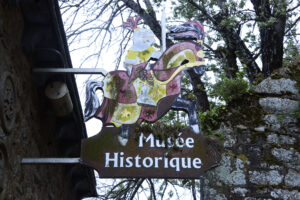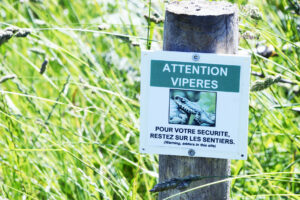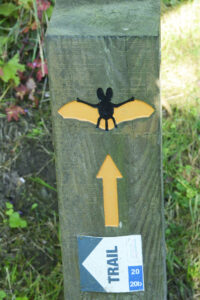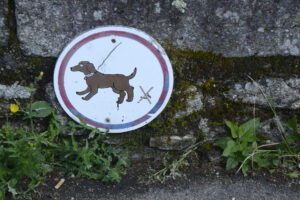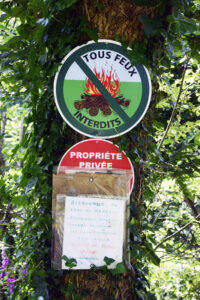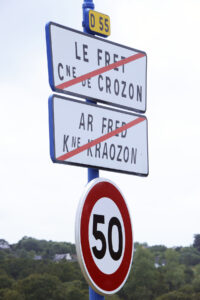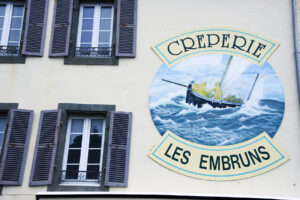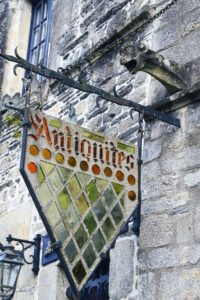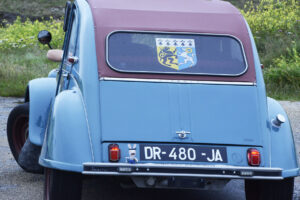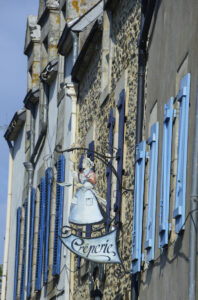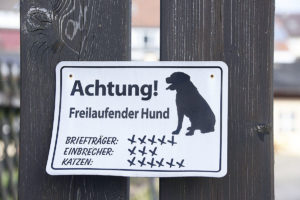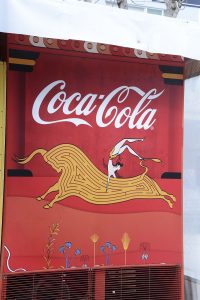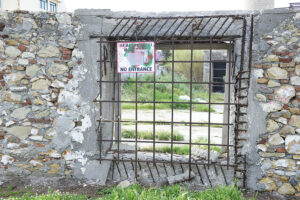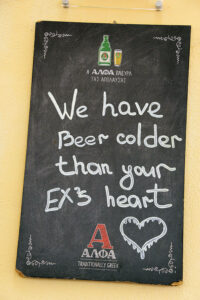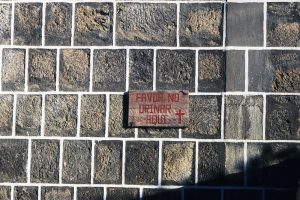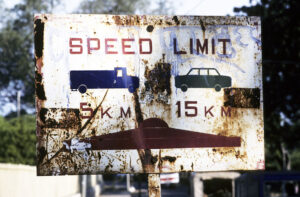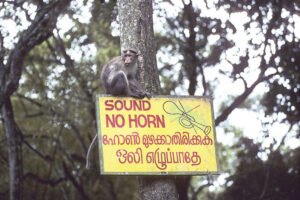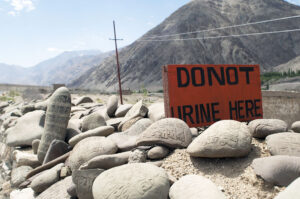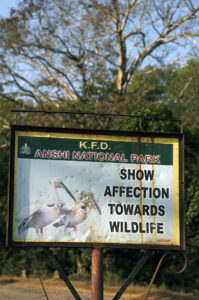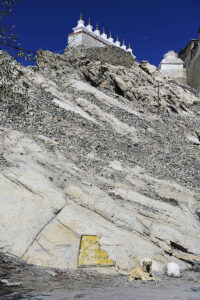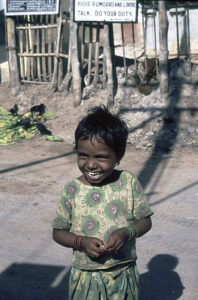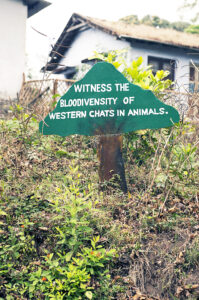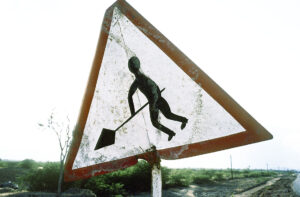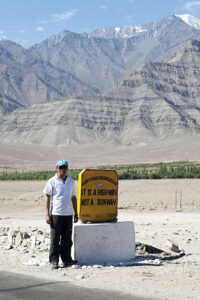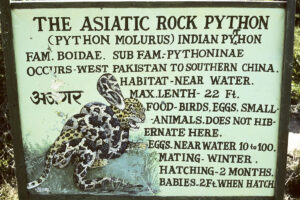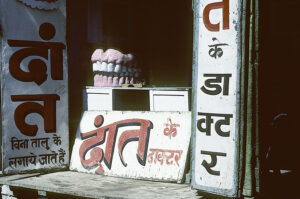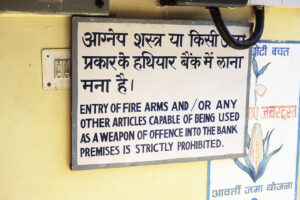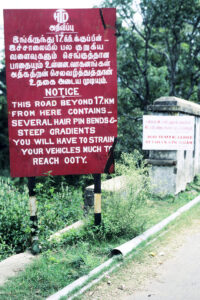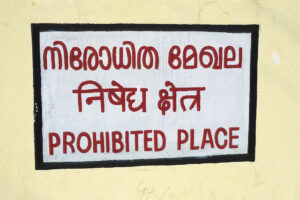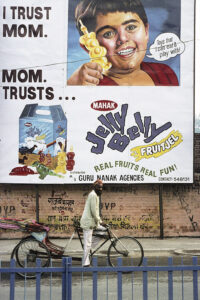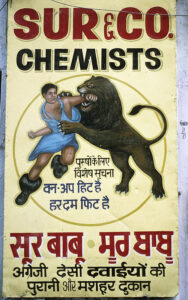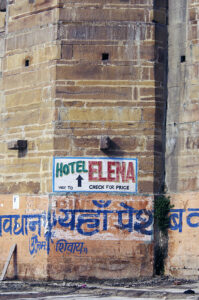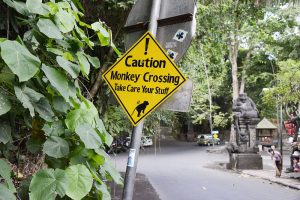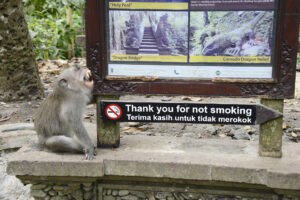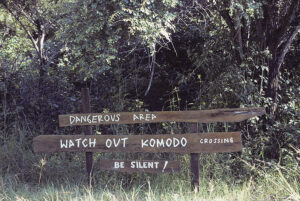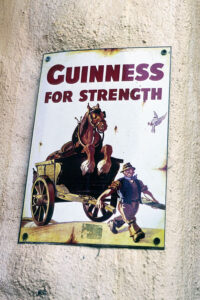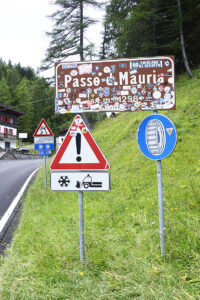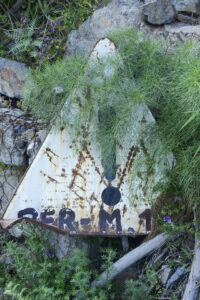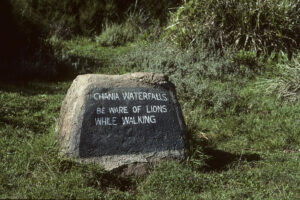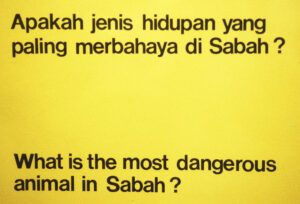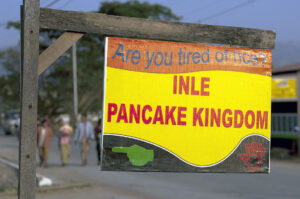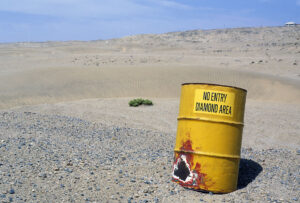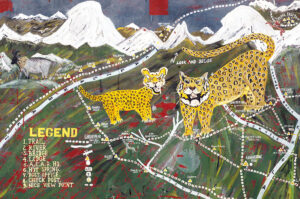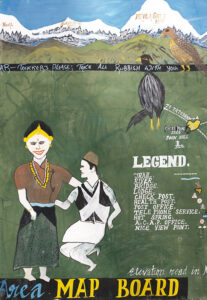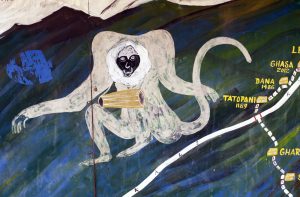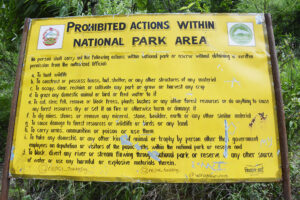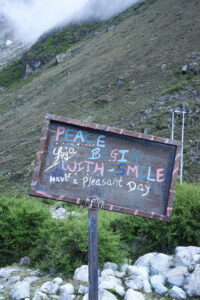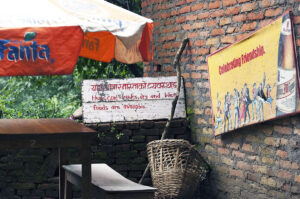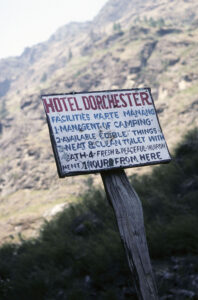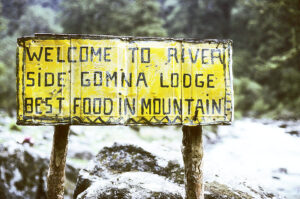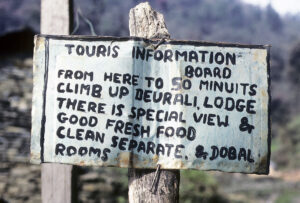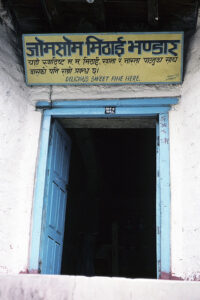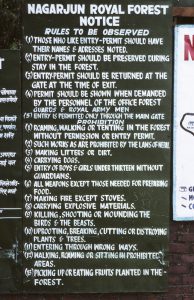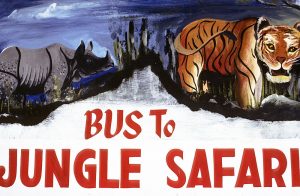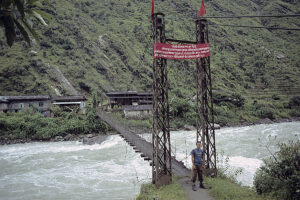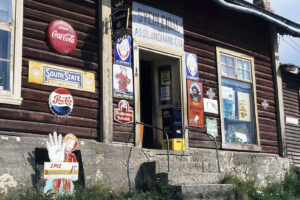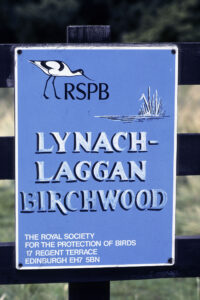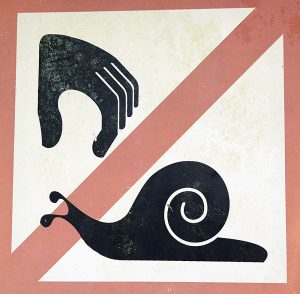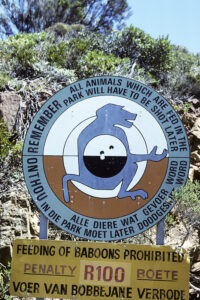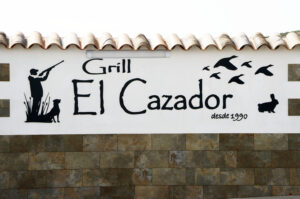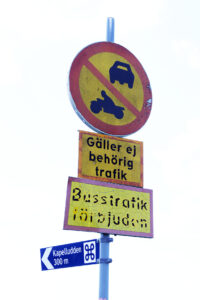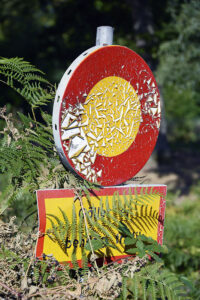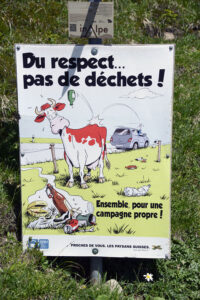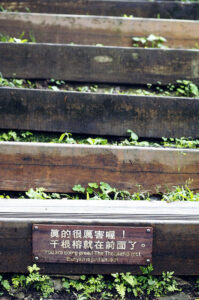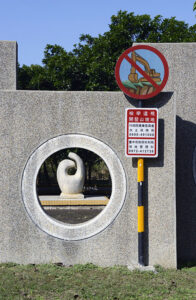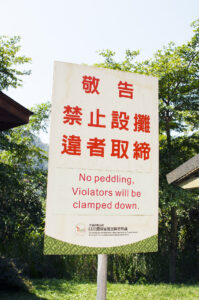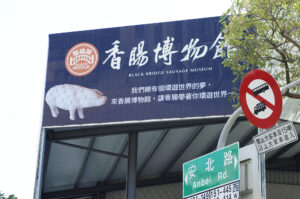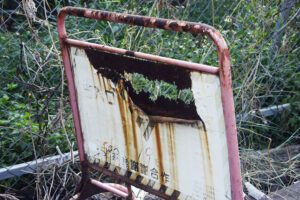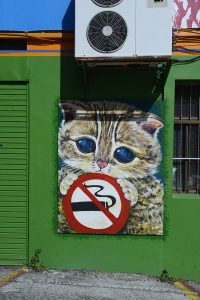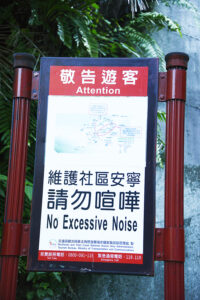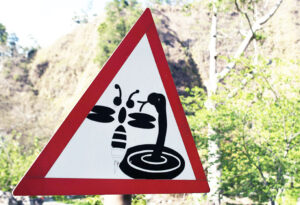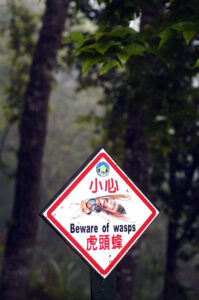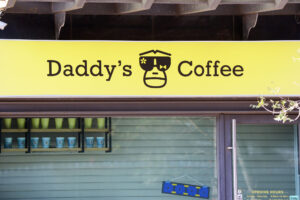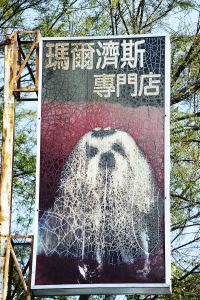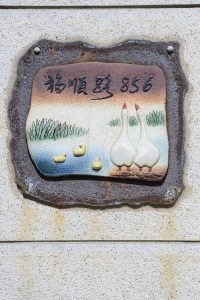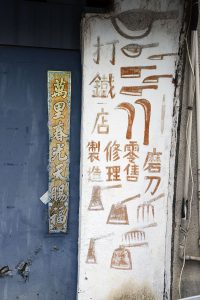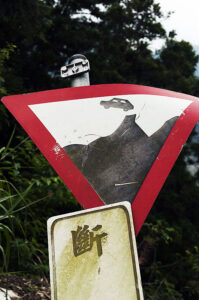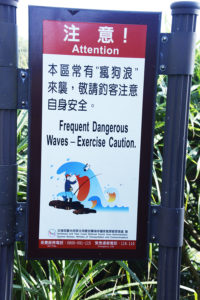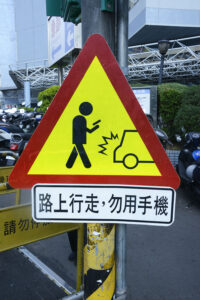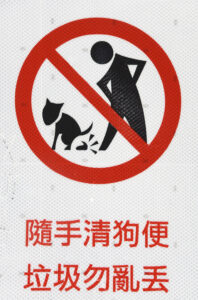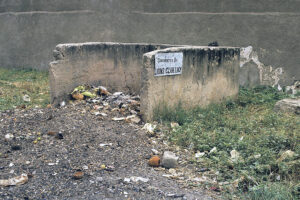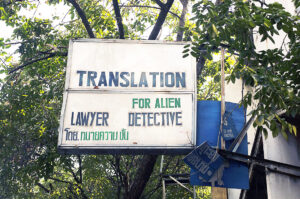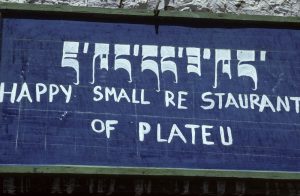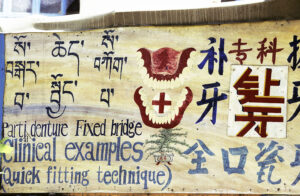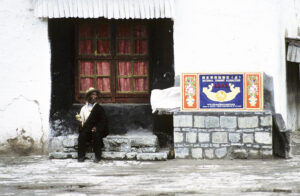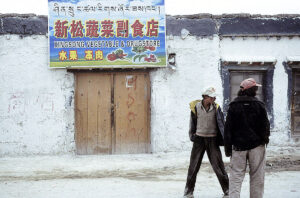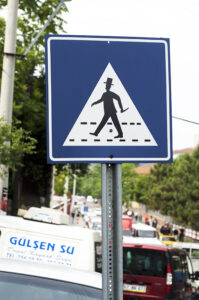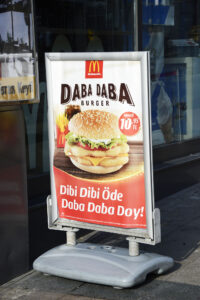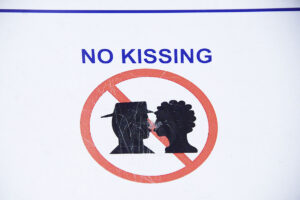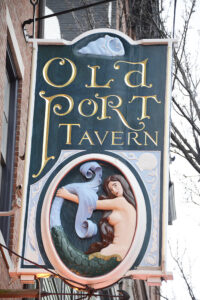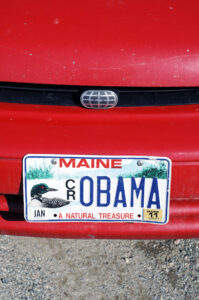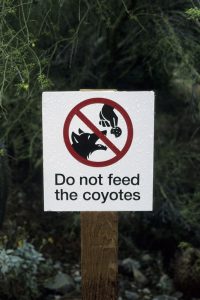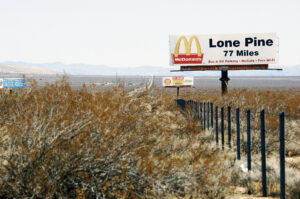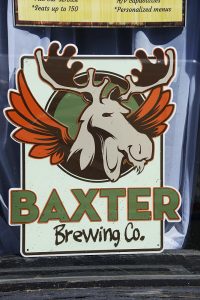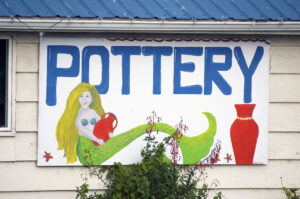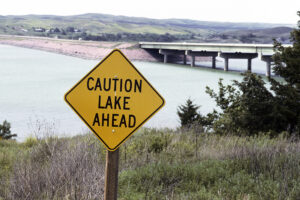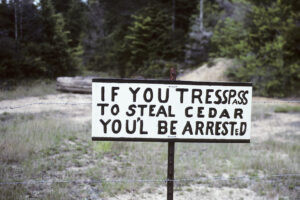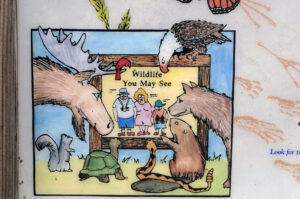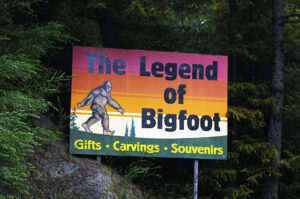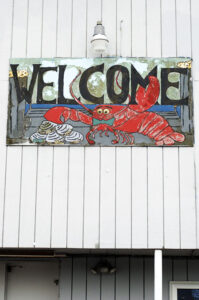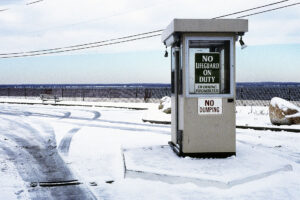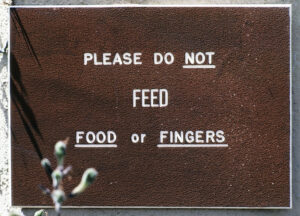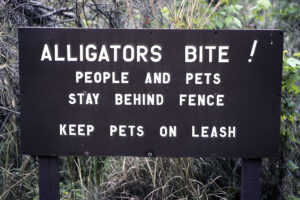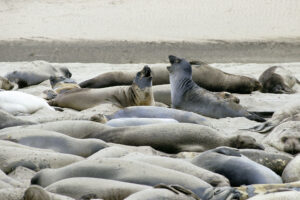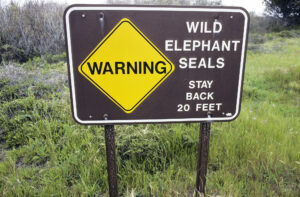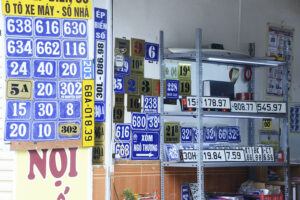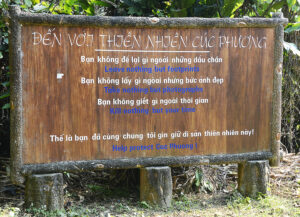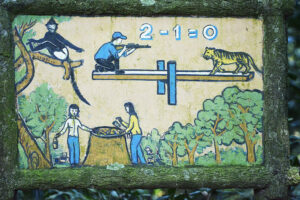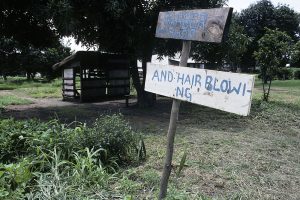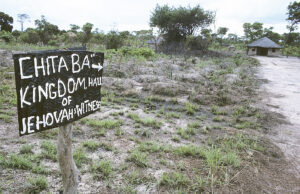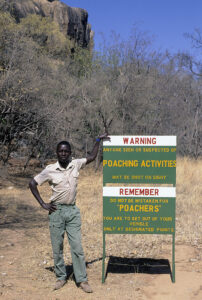Signs
These signs, showing remarkable English, are displayed at bridges in Alishan National Forest, Taiwan.
Why six men? (Photo copyright © by Kaj Halberg)
No admittance for suicides? (Photo copyright © by Kaj Halberg)
Who is going to count? (Photo copyright © by Kaj Halberg)
In most countries of the world, traffic signs warn drivers against crossing wildlife. In former days, the signs depicted larger animals, which constituted a danger to the driver and his vehicle. In later years, however, many signs have appeared, which urge drivers to slow down, as small animals like frogs or hedgehogs often cross the road – not for the sake of traffic security, but to avoid mass death among these small animals due to fast-moving vehicles. A selection of pictures below shows traffic signs, depicting various animals.
Numerous countries have more or less identical traffic signs, depicting deer jumping across the road.
Schladminger Tauern, Austria. (Photo copyright © by Kaj Halberg)
Sicily. (Photo copyright © by Kaj Halberg)
It seems that a frustrated hunter (or whatever one should call him) has ‘decorated’ this sign from Funen, Denmark. (Photo copyright © by Kaj Halberg)
This extremely worn sign was observed in the Son Tra Nature Reserve, near Da Nang, Vietnam. (Photo copyright © by Kaj Halberg)
The moose (Alces alces) is a huge species of deer, comprising about 7 subspecies, distributed in the entire taiga zone in the Northern Hemisphere, from Norway to eastern Siberia, and in Alaska, Canada, and northern United States. In Sweden and other places, this species has adapted to other types of forest, and can also be encountered in open areas, including fields.
This picture is from the island of Öland, Sweden. (Photo copyright © by Kaj Halberg)
The endemic Taiwan macaque (Macaca cyclopis) is a protected animal in Taiwan and is fairly common in most parts of the island. This species and other monkeys are presented in detail on the page Animals – Mammals: Monkeys and apes.
Sign, warning against crossing Taiwan macaques, Linnei. (Photo copyright © by Kaj Halberg)
This Taiwan macaque in Linbei Chukou, near Linnei, is waiting to be fed by tourists beside a sign, which urges people not to do so. The presence of the monkey is proof that this rule is often violated. (Photo copyright © by Kaj Halberg)
The domestication of wild horses (Equus ferus) is described in depth on the page Animals: Animals as servants of Man. Today, horses are mainly used for sports and leisure, but in certain parts of the world, especially South America, cowboys still work on horseback.
Horses on the road! – Sign west of Turangi, New Zealand. (Photo copyright © by Kaj Halberg)
Road sign, warning against horse carts, between Kavak and Havsa, Turkey. (Photo copyright © by Kaj Halberg)
The sad fate of elephants is dealt with in detail on the page Animals – Mammals: Rise and fall of the mighty elephants.
In Hwange National Park, Zimbabwe, I came across this sign, warning against crossing elephants (Loxodonta africana). (Photo copyright © by Kaj Halberg)
Snakes on the road! Signs in Taipingshan National Forest (top), and Dasyueshan National Forest, Taiwan. (Photos copyright © by Kaj Halberg)
The guanaco (Lama guanicoe) is a camelid, which is distributed from Peru and southern Bolivia southwards to Tierra del Fuego. It is fairly common in many places.
In Parque Nacional Pan de Azucar, Chile, you may encounter guanacos on the road. (Photo copyright © by Kaj Halberg)
This sign near Nanya Peculiar Rocks, northern Taiwan, announces the following: “Bats are often flying in this area! Slow down!” (Photo copyright © by Kaj Halberg)
Originally, the ring-necked pheasant (Phasianus colchicus) was native to Asia, from the Caucasus eastwards to China and Taiwan. However, it was introduced in Europe as a hunting object, maybe as early as around year 1000, and in North America in 1773. Today, it is firmly established as a feral bird in major parts of both continents.
This home-made sign on the island of Öland, Sweden, is warning against crossing ring-necked pheasants. (Photo copyright © by Kaj Halberg)
Swinhoe’s pheasant (Lophura swinhoii) is fairly common in the mountains of central Taiwan, but is found nowhere else. – This species is described on the page Animals – Birds: Birds in Taiwan.
This sign in Yushan National Park is warning against crossing Swinhoe’s pheasants. (Photo copyright © by Kaj Halberg)
Another endemic pheasant in Taiwan is the mikado pheasant (Syrmaticus mikado), which is restricted to the highest mountain areas.
These signs in Dasyueshan National Forest, of which the upper one shows a pair of Mikado pheasants, urge car drivers to drive slowly, and not to honk the horn. (Photo copyright © by Kaj Halberg)
In many countries, domestic cattle (Bos taurus) are roaming the countryside outside enclosures, and you must be aware that you may encounter them any time.
Cattle crossing the road! – Sign in Thy, Denmark. (Photo copyright © by Kaj Halberg)
A rather scrawny cow on a sign in northern Turkey. (Photo copyright © by Kaj Halberg)
Signs with a more healthy looking cow, and a caterpillar, San Cataldo, Sicily. (Photo copyright © by Kaj Halberg)
This sign is seen many places in Gran Canaria, here in the Roque Nublo area. Strangely enough, we didn’t see a single roaming cow during a week’s stay, but plenty of sheep. Pictures, depicting the remarkable Roque Nublo, are shown on the page Nature: Rocks and boulders. (Photo copyright © by Kaj Halberg)
In 2012, seven vicents, or European bison (Bos bonasus), were released in a 200-hectare enclosure in the forest Almindingen, Bornholm, Denmark. Despite the fact that many calves have been born, diseases have taken their toll, and in 2019, only 12 animals were living in the area. Presumably, the very small genetic pool in the few vicents, which survived World War II, weakens the animals.
(Photo copyright © by Kaj Halberg)
The black-crowned night-heron (Nycticorax nycticorax) is distributed in most warmer areas of the world. It is a common breeding bird in the lowland of Taiwan. This sign in Taichung has been placed near a mixed breeding colony of this species and the cattle egret (Bubulcus ibis). (Photo copyright © by Kaj Halberg)
Tortoises and turtles are slow animals, and thousands are killed on roads annually.
This homemade sign in Reeds Beach, Delaware Bay, New Jersey, United States, warns against turtles on the road. (Photo copyright © by Kaj Halberg)
The first donkeys (Equus africanus ssp. asinus) to enter the Americas were brought to the island of Hispaniola in 1495, during the second voyage of Columbus. In Mexico, donkeys probably arrived in 1528, from where they quickly spread northwards, used as pack animals by soldiers, missionaries, and miners. During the Gold Rush in the 19th century, the donkey, or burro, as it was called, was the main pack animal. When the Gold Rush ended, many burros escaped, or were deliberately released, forming feral populations, which have existed until today.
The taming of the wild ass is described on the page Animals: Animals as servants of Man, and the life and death of a remarkable burro named Prunes is described on the same page.
This traffic sign in Death Valley National Park, California, warns against burros on the road. (Photo copyright © by Kaj Halberg)
Kiwis are five species of flightless birds of the genus Apteryx, which are restricted to New Zealand. They belong to a group of birds, called ratites, which also include ostriches, emus, rheas, and cassowaries. Kiwis have become a national icon of New Zealand and the unofficial national emblem of the country. All species are threatened by introduced mammals, including dogs, cats, stoats, and ferrets, and huge measures have been taken by national and local authorities to save these birds from extinction.
Traffic signs in Waipoua Forest (top), and in Tongariro National Park, warning drivers against crossing kiwis. (Photos copyright © by Kaj Halberg)
Strict measures have been taken to prevent dogs from entering areas, where kiwis thrive. This sign was seen at the entrance to Taranaki National Park. (Photo copyright © by Kaj Halberg)
Kiwi, used as an eye-catcher on a restaurant sign, Whangarei. (Photo copyright © by Kaj Halberg)
The three signs below were encountered in wild areas, far away from habitation, in Taroko National Park, central Taiwan. The upper two are warning against endemic Taiwan serows (Capricornis swinhoei) on the road, or, as the text says, ‘wild mountain goats with long hair on their head.’ The third sign is warning against crossing ‘feathered bipeds’ (i.e. birds).
Clearly, the artist who made these signs, hadn’t got a clue what a serow looks like, but has depicted domestic goats, of which one has a beard, and horns curving forward, whereas the other has huge horns. The serow has no beard, and its very short horns are curving slightly backwards. Also, he didn’t know much about wild birds, since he has depicted a turkey!
(Photos copyright © by Kaj Halberg)
The American black bear (Ursus americanus) is widely distributed in North America, living in forested areas from Alaska and northern Canada southwards through the United States (where it has a patchy distribution), to mountain areas of Mexico.
Black bears are common in Sequoia National Park, California. (Photo copyright © by Kaj Halberg)
Signs, depicting crabs on the road, must be very rare indeed.
The text on this sign in Kenting National Park, southern Taiwan, reads as follows: “Crabs crossing the road! Reduce speed!” (Photo copyright © by Kaj Halberg)
Hedgehogs are often killed by cars, and they have declined drastically in many places.
This sign on the island of Öland, Sweden, warns car drivers against crossing European hedgehogs (Erinaceus europaeus). (Photo copyright © by Kaj Halberg)
The cougar (Puma concolor), also known as puma or mountain lion, has a very wide distribution, found from the Yukon area in Canada southwards through western North America to the southern Andes of South America. This large cat is very adaptable, found in almost all habitat types in this vast area.
Until 2005, it was believed that the tiny population of cougars in Florida, often called Florida panthers, constituted a distinct subspecies, P. concolor ssp. coryi. However, recent genetic studies have concluded that all North American cougars are very similar, and all former subspecies here have now been lumped in the subspecies couguar.
In the 1970s, it was estimated that as few as 20 cougars remained in the wild in Florida, but strict conservation measures have caused the population to increase to an estimated 230 by 2017.
This sign in Everglades National Park, Florida, warns that cougars may cross the road. (Photo copyright © by Kaj Halberg)
Every year, frogs and toads are killed by the millions in the traffic.
Frogs often cross the road in this area near Dongshih, Taiwan. (Photo copyright © by Kaj Halberg)
The fate of many amphibians, in this case common Asian toad (Duttaphrynus melanostictus), encountered in the city of Taichung, Taiwan. (Photo copyright © by Kaj Halberg)
In Turkey, you may encounter domestic pigs (Sus domestica) as well as wild boar (Sus scrofa), on the roads. – The domestic pig is described in detail on the page Animals: Animals as servants of Man.
(Photos copyright © by Kaj Halberg)
Signs, depicting poultry on the road, may be seen in several countries.
Lloyd Harbor, Long Island, United States. (Photo copyright © by Kaj Halberg)
Lake Tikitapu (‘Blue Lake’), New Zealand. (Photo copyright © by Kaj Halberg)
This homemade sign on the island of Lyø, Funen, Denmark, warns against crossing poultry. (Photo copyright © by Kaj Halberg)
Around the world, traffic signs urge drivers to slow down because of crossing school children, or children playing on the road.
In remote corners of Denmark, you occasionally encounter old-fashioned traffic signs which, miraculously, have survived the ubiquitous modernization tendency. In the upper sign, from eastern Zealand, children trot towards school, bags in hand, the girl dressed in a skirt. The lower sign, erected on a street near a sports ground in eastern Jutland, shows similar but a little older children.
(Photos copyright © by Kaj Halberg)
The modern Danish school children signs depict children with ugly, circular heads – a stark contrast to the fine old signs above. – Funen. (Photo copyright © by Kaj Halberg)
As opposed to the peacefully trotting children in the pictures above, the school boy in this traffic sign, observed in the town of Munnar, Kerala, South India, is running for dear life. He is probably aware that Indian drivers show very little respect for pedestrians! (Photo copyright © by Kaj Halberg)
Chubby Taiwanese school children, Taichung. (Photo copyright © by Kaj Halberg)
As a contrast, these children on a sign in Hanoi, Vietnam, are rather skinny. (Photo copyright © by Kaj Halberg)
Two traffic signs, one clearly home-made, from the island of Öland, Sweden, warning car drivers against playing children. (Photos copyright © by Kaj Halberg)
Traffic sign, depicting children playing on the road, Wanda, near Wushe, central Taiwan. (Photo copyright © by Kaj Halberg)
Parents and their children may cross the road! – Sign near Dumre, Nepal. (Photo copyright © by Kaj Halberg)
Sign with playing children, Mols, Denmark. (Photo copyright © by Kaj Halberg)
Children and dogs on the road, no motor traffic! – Madou, near Tainan, Taiwan. (Photo copyright © by Kaj Halberg)
Sign, urging drivers to drive slowly because of playing children, Oyster Bay, Long Island, United States. (Photo copyright © by Kaj Halberg)
Many places around the world, unbelievable amounts of signs are often displayed on the same spot, confusing by-passers and causing them to lose interest in studying them.
Huge collections of signs in the Taiwanese cities Kaohsiung (top) and Taichung. (Photos copyright © by Kaj Halberg)
In one of these signs in the city of Thiruvananthapuram, Kerala, South India, Santa is handing out Coca Cola as Christmas gifts. As the temperature in this area all year around is about 28o Centigrade, he must be terribly hot in his outfit! (Photo copyright © by Kaj Halberg)
An overwhelming amount of information, Brösarps Backar, Skåne, Sweden. (Photo copyright © by Kaj Halberg)
Algeria
A somewhat superfluous sign, warning against sand on the road, Sahara Desert. (Photo copyright © by Kaj Halberg)
Austria
At Lake Toplitz, near Bad Aussee, I noticed the sign in the picture below, which urges visitors not to throw garbage in nature, informing them, how long it really takes for certain items to break down completely: cigarette butts and chewing gum 5 years; plastic bottle 300 years; aluminum can 500 years; and glass bottle 4,000 years. The ‘beetle’ on the sign is composed of a plastic bottle, a disposable can, and cigarette butts.
(Photo copyright © by Kaj Halberg)
This sign in Lammartal Valley says “Honey for sale.” – It was probably placed here in the summertime, but maybe there is still a few jars left? (Photo copyright © by Kaj Halberg)
Botswana
Sign outside a chemical plant in Palapye, warning against drinking the water. (Photo copyright © by Kaj Halberg)
Chile
El Gloton – dream restaurant for gluttons, Valparaiso. (Photo copyright © by Kaj Halberg)
Warning! Very steep road ahead! – Parque Nacional Fray Jorge. (Photo copyright © by Kaj Halberg)
China
Pictures from Tibet are shown in a separate caption.
This sign along a highway in the Yunnan Province shows remarkable English. (Photo copyright © by Kaj Halberg)
Is this garbage container only for organisms? – Anshun, Guizhou Province. (Photo copyright © by Kaj Halberg)
In the Black Necked Crane Hotel, Weining, Guizhou Province, I noticed this sign on the counter. At first sight, the meaning of the text was not quite obvious, but ‘with a little help from my friends’, some light was thrown on it: Guests were requested not to leave any valuables in their room. (Photo copyright © by Kaj Halberg)
Outside a shop in Yuanyang, Yunnan Province, I noticed this sign with a remarkable English text: “Yuxin the bed is last toreside the decoratins.” – I was told that the shop sold bedroom decoration. (Photo copyright © by Kaj Halberg)
This photo studio in Guiyang, Guizhou Province, can compete with the famous town in Wales about possessing the world’s longest name: HAPPYBOYCHILDPHOTOGRAPHYORGANIZATION. (Photo copyright © by Kaj Halberg)
Costa Rica
Exclusive tobaccos for sale, Tilarán, Cordillera de Tilarán. (Photo copyright © by Kaj Halberg)
Sign, instructing people to leave hatchlings of sea turtles alone, Tortuguero National Park, Limón. (Photo copyright © by Kaj Halberg)
Private house, which is also a tour info centre, Tortuguero National Park. (Photo copyright © by Kaj Halberg)
This shoemaker in Puerto Jiménez, Peninsula de Osa, also sells ‘new sandals.’ (Photo copyright © by Kaj Halberg)
Denmark
The name on this stone means ‘a grove of trees’ – a somewhat pretentious name for this property in eastern Funen, with only 3 scattered trees, and several hundred metres to the nearest wood. (Photo copyright © by Kaj Halberg)
This home-made sign on the island of Bornholm announces that the road ahead is extremely bumpy. (Photo copyright © by Kaj Halberg)
On the island of Lyø, Funen, is a so-called ‘wind telephone’, from where you can ‘call’ a beloved deceased person. The idea of this kind of phone originated in Japan, where Itaru Sasaki mourned his deceased cousin. He got the idea to buy a telephone box and placed it on a hill, overlooking the Pacific Ocean. Every day he ‘called’ his cousin, and his words flew with the wind – hence the name wind phone.
The wind telephone on Lyø is the only one of its kind in Europe.
(Photo copyright © by Kaj Halberg)
Dog shit? No, thank you! – Nyborg. (Photo copyright © by Kaj Halberg)
One must hope that the cows are in a better shape than the window. – Lyø, Funen. (Photo copyright © by Kaj Halberg)
Old sign on a house wall, Svaneke, Bornholm: ‘Bicycles leaning against the wall are not allowed’. Below the sign is an even older ring for tethering horses. (Photo copyright © by Kaj Halberg)
Signs at the harbour, Lyø, Funen. (Photo copyright © by Kaj Halberg)
Slow down! Pedestrians on the road! – Sign near the cliffs of Møn. (Photo copyright © by Kaj Halberg)
Harpoon fishing not permitted, and bathing at your own risk, Nyborg Harbour. (Photo copyright © by Kaj Halberg)
The picture below shows an old conservation sign on a hill named Agri Bavnehøj, Mols Bjerge, Jutland. The text says: “This pillar and the ground around it at a distance of 2 m are protected. In particular, lighting a fire on or near it is forbidden.”
Not a very effective protection, one must say. What about the hill itself?
(Photo copyright © by Kaj Halberg)
Army shooting range, Djursland. (Photo copyright © by Kaj Halberg)
Due to a grammatical mistake, this sign outside a farm in Jutland announces one Salmonella-tested egg for sale. Or maybe the others are not Salmonella-tested? (Photo copyright © by Kaj Halberg)
Egypt
How long will it take, before you die? – Sign outside the Horus Temple, Edfu. (Photo copyright © by Kaj Halberg)
France
This rusted plaque, overgrown by lichens, has been attached to a coastal rock on the island Mont St. Michel, on the border between Normandy and Brittany. The text is hard to read, but mentions an association in Mont St. Michel. (Photo copyright © by Kaj Halberg)
Museum of History, Mont St. Michel. The sign is also almost historical! (Photo copyright © by Kaj Halberg)
This sign in the city of Dinan, Brittany, announces naivistic art for sale. (Photo copyright © by Kaj Halberg)
This rusted sign on the wall of the Cap Frehel lighthouse, Brittany, is functioning as a collection box for donations for the search and rescue service. (Photo copyright © by Kaj Halberg)
Warning against vipers (Vipera berus), Le Gouffre, Plougrescant, Brittany. (Photo copyright © by Kaj Halberg)
Follow the bat trail! – Le Grand Rocher, Plestin les Greves, Brittany. (Photo copyright © by Kaj Halberg)
Clean up after your dog, please! – Huelgoat, Brittany. (Photo copyright © by Kaj Halberg)
Fires prohibited. The lower sign says: “Welcome to Chaos du Mardoul.” The other messages urge you to behave decently. – Brittany. (Photo copyright © by Kaj Halberg)
These signs announce that you are now leaving the town of Le Fret, Crozon, Brittany, with text in French and Breton Gaelic. (Photo copyright © by Kaj Halberg)
Restaurant Spray, Camaret-sur-Mer, Brittany. (Photo copyright © by Kaj Halberg)
This sign in Rochefort en Terre, Brittany, announces antiques for sale. (Photo copyright © by Kaj Halberg)
Sign with the Brittany coat of arms in the rear window of a Citroen 2CV, Pointe du Toulinguet, Brittany. (Photo copyright © by Kaj Halberg)
Café, Quimper, Brittany. (Photo copyright © by Kaj Halberg)
Sign, depicting the coat of arms of the city of Pont-Croix, Brittany. (Photo copyright © by Kaj Halberg)
This sign was seen outside a restaurant, specializing in pancakes, Rochefort en Terre, Brittany. (Photo copyright © by Kaj Halberg)
Germany
This sign in Bühlertal, Black Forest, reads as follows: “Watch out! Free-running dog. Postman 5, Burglars 3, Cats 6.” (Photo copyright © by Kaj Halberg)
Greece
On the island of Crete, according to Greek mythology, Minos and his brothers competed to rule. To win the power, Minos prayed to the sea god Poseidon, asking him for a snow-white bull, as the bull was a symbol of power in the kingdom. His wish was granted. He was supposed to sacrifice the bull in honour of the deity, but found it so beautiful that he kept it for himself, thinking that Poseidon would not mind. He was wrong, however. To punish him, Poseidon made his wife Pasiphaë fall deeply in love with the bull. She persuaded a craftsman to make a hollow wooden cow and climbed inside it, whereupon the bull mated with her. The resulting offspring had a bull’s head and tail, but a human body. Pasiphaë nursed Minotauros, as he was named, but he grew monstrous, feeding on human flesh.
On advice from the oracle at Delphi, Minos let his craftsmen construct a gigantic labyrinth, in which Minotauros was kept. To control the monster, it had to be fed with human flesh, and the people of Athens, who paid tribute to the kingdom of Crete, were ordered to send seven young men and seven maids to Crete as an offering to the monster on a regular basis. Several young men, who tried to kill Minotauros, got lost in the maze and were eaten by the monster.
Theseus was a hero, who had saved the people of Athens from several horrible beasts. When he heard about the misery on Crete, he volunteered to try to kill Minotauros. In his quest, he was assisted by King Minos’ daughter Ariadne, who handed him a ball of yarn, the end of which he attached at the entrance to the labyrinth. He then entered it, rolling out the yarn as he went deeper into it. When he had managed to kill the beast, he was able to find his way out of the maze by following the yarn. (Sources: en.wikipedia.org/wiki/Minotaur, and L. Hjortsø 1964. Græsk mytologi (‘Greek Mythology’), in Danish)
This poster in the city of Chania, Crete, which is advertizing Coca Cola, is surely inspired by the legend of Theseus, who is balancing on the back of Minotauros in the labyrinth. (Photo copyright © by Kaj Halberg)
Sign in Chania, informing you that this is not an entrance. Entry would be rather difficult anyway, and why would anybody want to visit this lot? (Photo copyright © by Kaj Halberg)
On this dilapidated door in the city of Rethymno, Crete, someone has written in Greek and English: ”Life is too short to drink cheap wine. Cheers!” (Photo copyright © by Kaj Halberg)
Sign outside a restaurant in Rethymno. (Photo copyright © by Kaj Halberg)
Guatemala
Churchgoers in San Pedro de Atitlan, Lago Atitlan, often have a few drinks before going to church. For this reason, they are in dire need to relieve themselves, when the service is over. This sign on the church wall, says: “Please do not urinate here.” (Photo copyright © by Kaj Halberg)
Holland
A rather cumbersome internet address on the back of a van, Enkhuizen. Slijterij means ‘wine shop’. (Photo copyright © by Kaj Halberg)
India
The speed limit is indeed very low, when you pass over this road bump near Khajuraho, Madhya Pradesh. – Before you have finished studying the sign, you may have had an accident! (Photo copyright © by Kaj Halberg)
Don’t disturb this bonnet macaque (Macaca radiata) in Periyar National Park, Kerala! – This species and many other monkeys are described on the page Animals – Mammals: Monkeys and apes. (Photo copyright © by Kaj Halberg)
Mani stones are stone slabs with chiseled Buddhist mantras. They are described in depth on the page Religion: Buddhism.
Sadly, on this row of mani stones near Upshi, Ladakh, it has been necessary to instruct tourists not to urinate at this sacred site. (Photo copyright © by Kaj Halberg)
I do hope that the spaghetti served in this restaurant in Pushkar, Rajasthan, is cleaner than their sign! (Photo copyright © by Kaj Halberg)
Sign in Anshi National Park, Karnataka, urging people to show affection towards wildlife. Obviously, poachers are of a different opinion, as they have shot at the sign. (Photo copyright © by Kaj Halberg)
In rocky areas of India, traffic-’signs’ are often painted on rock walls or large boulders. In this picture, a dog is resting beneath the poor remains of a ‘sign’ in Ladakh. The building in the background is Shey Palace, formerly residence of the King of Ladakh. (Photo copyright © by Kaj Halberg)
Happy little Tamil girl, Rameshwaram, Tamil Nadu. Note the official sign in the background: “Avoid rumours and loose talk. Do your duty.” (Photo copyright © by Kaj Halberg)
Is an ongoing feud taking place among western chatting animals? – Sign in Annamalai National Park, West Ghats, Tamil Nadu. (‘Bloodivensity’ should be ‘biodiversity’, and ‘Western Chats’ should be ‘Western Ghats’ – a mountain chain in South India. (Photo copyright © by Kaj Halberg)
Sign near Chittorgarh, Rajasthan, depicting a road worker, handling a rather inefficient shovel. (Photo copyright © by Kaj Halberg)
Road marker near Stakna Gompa, Ladakh, urging drivers to slow down. (Photo copyright © by Kaj Halberg)
Python is a genus of large constricting snakes, comprising 10 species, distributed in Africa south of the Sahara, and in the Indian Subcontinent, Indochina, Malaysia, and Indonesia. The Indian rock python (Python molurus) is found in the entire Indian Subcontinent and in Indochina.
In Ancient Greek mythology, Python was a huge serpent (sometimes depicted as a dragon), born by the mother goddess Gaia. Python resided in the temple at Delphi, which by the Ancient Greeks was regarded as the centre of the Earth, represented by a stone, which Python guarded.
In his book Fabulae, Roman author Gaius Julius Hyginus (c. 64 B.C. – 17 A.D.) relates that Zeus made love to the goddess Leto. His wife Hera got jealous, and when Leto was about to give birth, Hera ordered Python to pursue Leto, so that she was unable to deliver. However, Leto managed to give birth to the twins Apollo and Artemis, and when Apollo grew up, he wanted to avenge his mother. He travelled to Mount Parnassos, where the monster dwelled, and chased it to the Gaia Temple in Delphi, where he killed it with his arrows.
As is obvious from this info sign in Keoladeo National Park, Rajasthan, the rock python is a formidable predator. (Photo copyright © by Kaj Halberg)
This sign was seen at Mukkali, Kerala. The clustered chickens in the small cages are not so lucky. (Photo copyright © by Kaj Halberg)
White and regular teeth! – Dental clinic, Varanasi, Uttar Pradesh. (Photo copyright © by Kaj Halberg)
Firearms are not allowed to walk into this bank in Rudraprayag, Uttarakhand. (Photo copyright © by Kaj Halberg)
Warning sign, written in Tamil and English, Mudumalai Tiger Reserve, Tamil Nadu. (Photo copyright © by Kaj Halberg)
In dry Ladakh, north-western India, where water is scarce, an owner of a roadside restaurant has urged his customers not to waste water. (Photo copyright © by Kaj Halberg)
Poster in Amritsar, Punjab: “Managing money is an art, and not a science.” – Why not both? (Photo copyright © by Kaj Halberg)
This sign in Eravikulam National Park, near Munnar, Kerala, states the rules of the park. Now you have been warned! (Photo copyright © by Kaj Halberg)
This dog kennel in Mysore, Karnataka, provides many different dog breeds, but maybe they are not all genuine? – If your acquired dog doesn’t behave, you can buy drugs from another branch of the company. (Photo copyright © by Kaj Halberg)
How can this place in Kochi, Kerala, exist, if it’s prohibited? – The upper text is Malayalam (the main language of Kerala), in the centre Hindi. (Photo copyright © by Kaj Halberg)
Poster in Amritsar, Punjab, advertising candy: “Toys that I can eat and play with!” – Shouldn’t it be the other way around? (Photo copyright © by Kaj Halberg)
This rusted sign on a pole in Kerala is warning against high voltage, also in Malayalam, the main language of Kerala. (Photo copyright © by Kaj Halberg)
Eat our drugs, and you’ll be strong! – Sign outside a pharmacy, Amritsar, Punjab. (Photo copyright © by Kaj Halberg)
Unfortunately, this interesting exhibition at the post office seems to have been cancelled. – Annamalai National Park, West Ghats, Tamil Nadu. (Photo copyright © by Kaj Halberg)
Do you have to climb the wall to ask about the price? – Advertisement on a wall near the Ganges River, Varanasi. (Photo copyright © by Kaj Halberg)
Indonesia
Several troops of long-tailed macaques (Macaca fascicularis) live in a small forest, surrounding the Hindu Wenara Wana Temple, near Ubud, Bali. For this reason, this wood has been dubbed ‘Monkey Forest’.
The long-tailed macaque and many other monkeys are described on the page Animals – Mammals: Monkeys and apes.
Road sign near the Wenara Wana Temple, warning against thieving long-tailed macaques. (Photo copyright © by Kaj Halberg)
This long-tailed macaque in ‘Monkey Forest’ seems to agree that smoking is a nuisance! (Photo copyright © by Kaj Halberg)
The Komodo dragon (Varanus komodoensis) is the world’s largest lizard, growing to 3.5 m long and weighing up to 135 kilograms. This monitor lizard was unknown to science until the early 1900s. There are two reasons for this. Firstly, this species has a very limited distribution, found only on the small Indonesian islands of Komodo, Rintja, and Padar, and possibly in a very small area on the western tip of Flores. Secondly, these small islands were uninhabited until the 1800s, when convicts were deported to Komodo – a dry, inhospitable place with a very limited supply of freshwater.
My rather grotesque encounter with Komodo dragons is described on the page Travel episodes – Indonesia 1985: Difficult journey to Komodo.
Sign at a feeding area for Komodo dragons, Komodo Island National Park. Today, this practice has been banned. (Photo copyright © by Kaj Halberg)
The time of Fuji Films is over, but this sign in Kintamani, Bali, has remained, despite wear and tear. (Photo copyright © by Kaj Halberg)
Ireland
Sign outside a pub, promoting Guinness beer, in Cloghane, Dingle. – Another well-known slogan is: “Guinness is good for you!” (Photo copyright © by Kaj Halberg)
Italy
This dilapidated sign in the city of Mineo, Sicily, informs you that the water is not potable. Spreading pellitory-of-the-wall (Parietaria judaica) is growing on the sign. (Photo copyright © by Kaj Halberg)
This sign, indicating the altitude of Passo della Mauria (1298 m), Dolomites, is almost illegible, covered by scores of badges. (Photo copyright © by Kaj Halberg)
This sign, hidden behind a leaf of giant fennel (Ferula communis), has seen better days, Pineta di Graniti, Sicily. What it is warning against, is not quite obvious. (Photo copyright © by Kaj Halberg)
Kenya
Warning, painted on a rock, Chania Waterfalls, Aberdare National Park. (Photo copyright © by Kaj Halberg)
Malaysia
Sign next to a mirror, Sepilok Orangutan Rehabilitation Centre, Sabah, Borneo. (Photo copyright © by Kaj Halberg)
Myanmar
Just in case! – Nyaung Shwe, Lake Inle. (Photo copyright © by Kaj Halberg)
Sign outside a shop in Old Bagan. – Credit cards are welcome, but what about their owners? (Photo copyright © by Kaj Halberg)
Namibia
The text on this discarded oil drum forbids entry into a diamond area near Lüderitz. This area and other places in Namibia are described on the page Countries and places: Namibia – a desert country, (Photo copyright © by Kaj Halberg)
Nepal
”Look and decide!”
Along many trails in the Himalaya, you find interesting information boards, painted by local artists, showing hiking trails, mountains, rivers, villages, and a selection of the local wildlife. These three boards were all encountered in the Modi Khola Valley, Annapurna.
This board depicts a Himalayan tahr (Hemitragus jemlahicus), a leopard (Panthera pardus), and a creature, which is probably supposed to be a snow leopard (Panthera uncia), but rather more resembles a hybrid between a leopard and a tiger (Panthera tigris). (Photo copyright © by Kaj Halberg)
This board depicts mountains, a dancing couple, and a pair of kalij pheasants (Lophura leucomelanos). (Photo copyright © by Kaj Halberg)
On this board, a pale-armed langur (Semnopithecus schistaceus) is playing a tabla. – Langurs and many other monkeys are presented on the page Animals – Mammals: Monkeys and apes. (Photo copyright © by Kaj Halberg)
Dog, sleeping beneath a sign in Kathmandu, with the following slogan (in English and Nepali): “Clean green healthy Kathmandu.” – The surroundings seem to belie this allegation. (Photo copyright © by Kaj Halberg)
Apparently, the white-water rafting depicted on this sign in Kathmandu takes place during a hurricane! (Photo copyright © by Kaj Halberg)
This sign in Langtang National Park describes the park rules, which, however, are largely ignored, and the authorities seem indifferent to these violations. (Photo copyright © by Kaj Halberg)
Grafitti on the rear side of a sign, Kyangjin Gompa, Langtang Valley. (Photo copyright © by Kaj Halberg)
Along the trekking routes in the mountains of Nepal, I have often come across signs with peculiar English. A selection is shown below.
Sign at small wayside restaurant in the village of Sundarijal, near Kathmandu, announcing that ‘dry and wet foods are available’. (Photo copyright © by Kaj Halberg)
There are many facilities in Hotel Dorchester, but I hope they are in a better condition than the sign. – Marsyangdi Valley, Annapurna. (Photo copyright © by Kaj Halberg)
Are the meals prepared inside a mountain? – Ghumna, Langtang National Park. (Photo copyright © by Kaj Halberg)
In this fancy shop you can get woolen ‘godis’ and yakbone ‘soovenirs’. – Thangshyap, Langtang National Park. (Photo copyright © by Kaj Halberg)
‘Touris information board’, announcing ‘dobal rooms’, Banthanti, Annapurna. (Photo copyright © by Kaj Halberg)
“Delicious sweet fine here.” – Sign outside a shop in the village of Marpha, Kali Gandaki Valley. Are you going to get fined here, but in a nice way? No, on the contrary, you can find delicious sweets inside the shop. (Photo copyright © by Kaj Halberg)
The day has probably ended, before you have finished reading this sign at the entrance to Nagarjun Royal Forest, Kathmandu, informing visitors about park rules and regulations. (Photo copyright © by Kaj Halberg)
This sign is advertising jungle safaris to Chitwan National Park. – It seems that this park is the home of enormous tigers! (Photo copyright © by Kaj Halberg)
In 2004, when I visited the Bhote Kosi Valley, central Nepal, this area was controlled by Maoist rebels, fighting against the government. I had to pay a ‘donation’ of 1000 Rupees, or I would not be allowed to pass this village, but otherwise the Maoists were very polite towards me.
In the picture below, my guide Ganga Thapa is standing in front of a suspension bridge across the Bhote Kosi River, near the village of Jagat. The red banner on the bridge reads as follows: “Let us fight against the government. Help the low castes and get rid of the caste system.”
(Photo copyright © by Kaj Halberg)
New Zealand
Signs outside a butcher’s shop in the town of Patea, North Island. (Photo copyright © by Kaj Halberg)
Sign in a restaurant, Patea. (Photo copyright © by Kaj Halberg)
In many areas of New Zealand, signs like this one announce, in English and in the Maori language, that consumption of alcohol is banned. (Photo copyright © by Kaj Halberg)
Norway
A nice, old-fashioned grocery store with numerous old-fashioned signs, Nesbyen, Halling Valley, Buskerud. This picture was taken in 1978, so the shop may have disappereared a long time ago. (Photo copyright © by Kaj Halberg)
Scotland
Sign at Lynach-Laggan Birchwood, an RSPB (Royal Society for Protection of Birds) reserve, near Insh, Spey Valley. (Photo copyright © by Kaj Halberg)
Slovenia
Collecting Burgundy snails (Helix pomatia) is not allowed in the Krajcarca Valley, near Trenta, Triglavski National Park. (Photo copyright © by Kaj Halberg)
South Africa
The chacma baboon (Papio ursinus) lives in southern Africa. Where they are fed regularly by tourists, baboons often become aggressive and may have to be shot.
Baboons are dealt with in detail on the page Animals – Mammals: Monkeys and apes.
This sign in Cape of Good Hope National Park prohibits feeding of baboons. (Photo copyright © by Kaj Halberg)
Spain
Hunter’s grill, Gran Canaria. (Photo copyright © by Kaj Halberg)
This homemade sign near San Nicolas, Gran Canaria, warns against bees. (Photo copyright © by Kaj Halberg)
Sweden
Sign on a door, Hulterstad, Öland. (Photo copyright © by Kaj Halberg)
Dilapidated signs, Kapelludden, Öland. No entry for motor vehicles. The text says: ‘Vehicles with a legal purpose exempted’. The lower sign says: ‘No busses’. (Photo copyright © by Kaj Halberg)
No entry. – Dilapidated traffic sign in the village of Glömminge, Öland. If you remove the fern, you are informed that residents, or others with an errand, are allowed to enter. (Photo copyright © by Kaj Halberg)
Switzerland
This sign urges people not to throw garbage in the nature, Col de la Croix, Valais. (Photo copyright © by Kaj Halberg)
Taiwan
In Jhiben National Forest, eastern Taiwan, a steep flight of stairs leads up to a huge weeping fig (Ficus benjamina) with numerous stilt roots, called ‘Thousand-root Banyan’. The weeping fig and other fig species are described on the page Plants: Fig trees.
This sign has been placed halfway up the steep flight of stairs in Jhiben National Forest to encourage people, who are about to turn back. (Photo copyright © by Kaj Halberg)
Are excavators not allowed to remove the wall around this park in Taichung? (Photo copyright © by Kaj Halberg)
Info sign, Malabang National Forest. (Photo copyright © by Kaj Halberg)
According to this sign at Sun-Moon Lake, it is very risky to peddle here! (Photo copyright © by Kaj Halberg)
Commercial poster from the company Black Bridge, promoting their ‘Sausage Museum’, Anping. The Chinese text translates: “We always have a dream of traveling around the world. Come to the Sausage Museum and let the sausage take you around the world.” (Photo copyright © by Kaj Halberg)
The information on this sign in Taichung has been lost due to wear and tear. (Photo copyright © by Kaj Halberg)
Wall painting, depicting a kitten, urging people not to smoke in this area, Sanyi. (Photo copyright © by Kaj Halberg)
Sign at Bitou Cape Trail, northern Taiwan. – Is it up to each visitor to estimate, what ‘excessive noise’ means? (Photo copyright © by Kaj Halberg)
Motels in Taiwan often serve as love nests for men and their mistresses. The sign below informs you that you can do your business without fear. However, according to Oxford Dictionary, consumption means either ‘the action of using up a resource’, or ‘a wasting disease, especially pulmonary tuberculosis’. Make your choice!
(Photo copyright © by Kaj Halberg)
Kitschy sign, warning against a dangerous side trail on the Walami Trail, Yushan National Park. The announced danger has nothing to do with bears, however, although the Formosan black bear (Ursus thibetanus ssp. formosanus) is occasionally seen in this area. (Photo copyright © by Kaj Halberg)
These signs warn against snakes, bees, and wasps on hiking trails, Basianshan National Forest (top), along the Walami Trail, Yushan National Park (centre), and on Hu-tou Shan (‘Tiger Head Hill’), Tungxiao. (Photos copyright © by Kaj Halberg)
Coffee shop, Taichung. (Photo copyright © by Kaj Halberg)
Info sign with peculiar English, describing the foundation of the Cherry Blossom Garden in Alishan National Forest, where a small plantation of Tokyo cherry (Prunus x yedoensis) was established. (Photo copyright © by Kaj Halberg)
Sign, announcing sale of a dog breed, Taichung. Would you buy a dog in a shop, which displays a sign as dilapidated as this one? (Photo copyright © by Kaj Halberg)
Sign on a wall, indicating the house number, Taichung. (Photo copyright © by Kaj Halberg)
Outside this blacksmith’s shop in the village of Dalinpo, near Kaohshiung, the service is announced in the old-fashioned way. Painted on the wall, the text reads as follows: “Hammering iron shop. Retail, repair, production. Sharpening of knives”. – To the left, a faded New Year’s ribbon says: “Ten thousand miles of spring light gives out heavenly fortune” (i.e. money). (Photo copyright © by Kaj Halberg)
Advertisement for taekwondo, Taichung. (Photo copyright © by Kaj Halberg)
Why is the couple in this sign, displayed in Alishan National Forest, so happy, when they cannot enter without a permit? (Photo copyright © by Kaj Halberg)
Home-made sign near Rueilli: Beware of abyss ahead! (Photo copyright © by Kaj Halberg)
A most illustrative sign, warning anglers against dangerous waves, Bitou Cape Trail, northern Taiwan. (Photo copyright © by Kaj Halberg)
This sign in Taichung warns against staring at your mobile phone while walking in trafficked areas. (Photo copyright © by Kaj Halberg)
Is the price for these spring onions 50 or 5 Taiwan Dollars? We agreed that 5 TD would be extremely cheap and out of the question. – Shetou, between Changhua and Chiayi. (Photo copyright © by Kaj Halberg)
Old cracked sign with an unusual depiction of a street crossing, Shetou, between Changhua and Chiayi. (Photo copyright © by Kaj Halberg)
No dog shit, thanks! – Taichung. (Photo copyright © by Kaj Halberg)
Tanzania
Hairdresser’s sign: Muddy Hair Salon, Dar es Salaam. (Photo copyright © by Kaj Halberg)
Garbage dump, donated by Lion’s Club, Lindi. – If I were a member of this Lion’s Club, I wouldn’t be happy with the condition of this monument! (Photo copyright © by Kaj Halberg)
Thailand
Part of the text has faded on this sign board in Bangkok, and now it reads: “Translation for alien detective.” (Photo copyright © by Kaj Halberg)
Tibet
In 1987, I stayed a couple of weeks in the town of Shigatse. During my stay, a number of signs in this town caught my attention.
My at times rather grotesque adventures in Tibet are related on the page Travel episodes – Tibet 1987: Tibetan summer.
Sign above a small restaurant. (Photo copyright © by Kaj Halberg)
The huge Chinese propaganda poster in the picture below, depicting very happy Tibetan herders, is a striking contrast to the harsh conditions, which the Tibetans had to endure during The Cultural Revolution in the 1960s and 1970s. The text, in Chinese and Tibetan, announces the following: “Act together! Pay attention to hygiene! Prevent illness by raising your personal health level!”
(Photo copyright © by Kaj Halberg)
Sign board outside a dentist’s clinic. (Photo copyright © by Kaj Halberg)
You have to read this notice a couple of times, before you realize that the restaurant is closed due to a banquet. (Photo copyright © by Kaj Halberg)
Chinese commercial poster. (Photo copyright © by Kaj Halberg)
The picture below shows a pilgrim, resting beside a board, which announces that the Tashilhunpo Monastery in Shigatse is declared a ‘National Tourist Attraction’ by the National Tourist Administration of the People’s Republic of China. This picture was taken in 2004, when a radical change of attitude had taken place since the Cultural Revolution, where monasteries and other monuments were destroyed on a large scale.
(Photo copyright © by Kaj Halberg)
In this shop in the village of Tingri you can buy vegetables, and if they don’t go down too well, you can always come back here to buy some drugs! And when you have eaten the drugs, maybe you’ll xing a song? (Photo copyright © by Kaj Halberg)
Would you visit this ‘restaorant’ in Tingri, even if you were very hungry? (Photo copyright © by Kaj Halberg)
Chinese propaganda poster, promoting the Chinese way of learning, Lhasa. (Photo copyright © by Kaj Halberg)
Turkey
A stylish pedestrian! – Sign in the town of Zonguldak, Black Sea. (Photo copyright © by Kaj Halberg)
Burger, Turkish style, Istanbul. A lot of D’s! (Photo copyright © by Kaj Halberg)
Don’t climb on the ruins! – Sign at Hattuşa, capital of the Hittite Empire during the late Bronze Age, today situated near the town of Bogazkale (Bogazköy), central Turkey. (Photo copyright © by Kaj Halberg)
Sign outside the Nuruosmaniye Camii (‘Light of Osman Mosque’) in Istanbul, forbidding public kissing. Judging from the scratch marks around the mouths of the depicted couple, it seems that somebody agreed to the prohibition! (Photo copyright © by Kaj Halberg)
United States
Butcher’s catering van, Bayville, Long Island. – Does he kill babies? (Photo copyright © by Kaj Halberg)
Standing on an info sign in J. N. Darling National Wildlife Refuge, Florida, this American white ibis (Eudocimus albus) is preening. It is described on the page Animals – Birds: Birds in the United States and Canada. (Photo copyright © by Kaj Halberg)
Beautiful mermaid, advertising for a pub in Old Portland, Maine. (Photo copyright © by Kaj Halberg)
Car license plate, observed in Acadia National Park, Maine. Obviously, the car is owned by a supporter of Barack Hussein Obama (born 1961), American Democratic Party president 2009-2017. The plate also depicts a northern loon (Gavia immer), a coomon bird in Maine. It is described on the page Animals – Birds: Birds in the United States and Canada. (Photo copyright © by Kaj Halberg)
The coyote (Canis latrans), also called prairie wolf, is common and widespread in the major part of North America, southwards through Mexico to Panama. Due to its adaptability and its varied diet, which consists of smaller mammals, birds, reptiles, amphibians, fish, invertebrates, and occasionally fruits and vegetables, it has been able to expand into urban areas, despite being persecuted in many places.
The coyote is described in depth on the page Animals – Mammals: Dog family.
Sign, discouraging people from feeding coyotes, Tucson Mountain Park, Arizona. (Photo copyright © by Kaj Halberg)
Quite far to the next McDonald’s! Sign on Highway 14, California. (Photo copyright © by Kaj Halberg)
Sign, advertising apple cider, Long Island. – New England is famous for its production of excellent cider. (Photo copyright © by Kaj Halberg)
Old sign, advertising for Baxter Brewing Company, Old Town, Haverhill, Massachusetts. (Photo copyright © by Kaj Halberg)
Rules and regulations for Andrew Molera State Park, Big Sur, California. Some prankster has added: “No fun” on the sign. (Photo copyright © by Kaj Halberg)
Beware, dog owners! This sign indicates that you get a fine for having your dog on a leash, and also for cleaning up after it! – Winnekenni Park, Haverhill, Massachusetts. (Photo copyright © by Kaj Halberg)
A decently dressed mermaid, advertising pottery, Charlton, Coos Bay, Oregon. (Photo copyright © by Kaj Halberg)
You must be really sleepy or drunk not to notice this lake! The sign, however, may be useful in foggy weather. – Chamberlain, Missouri River, South Dakota. (Photo copyright © by Kaj Halberg)
Home-made warning sign, Charleston, Oregon. (Photo copyright © by Kaj Halberg)
Humourous sign, depicting ‘wildlife’, Parker River Wildlife Refuge, Massachusetts. (Photo copyright © by Kaj Halberg)
Does ‘Bigfoot’ sell gifts and souvenirs here? – Garberville, California. (Photo copyright © by Kaj Halberg)
Sign, urging visitors not to feed prairie dogs, Devil’s Tower, Wyoming. These ground-living squirrels are described on the page Animals – Mammals: Squirrels. (Photo copyright © by Kaj Halberg)
Sign outside a lobster restaurant, Southwest Harbor, Mount Island, Acadia National Park, Maine. (Photo copyright © by Kaj Halberg)
“No lifeguard on duty.” – This sign in Bayville, Long Island, seems a little irrelevant in December, when this picture was taken! (Photo copyright © by Kaj Halberg)
Humourous sign at the jaguar’s den, Tucson Desert Zoo, Arizona. (Photo copyright © by Kaj Halberg)
I wonder if the drinking water supply is also contaminated with mercury? – Kenoza Lake, Winnekenni Park Conservation Area, Haverhill, Massachusetts. (Photo copyright © by Kaj Halberg)
Sign, warning against American alligators (Alligator mississippiensis), Aransas National Wildlife Refuge, Texas. (Photo copyright © by Kaj Halberg)
Formerly, the northern elephant seal (Mirounga angustirostris), so named for its bizarre proboscis, was common as far north as Point Reyes, California. As each animal yielded about three barrels of oil, and its tongue was regarded as a delicacy, it was hunted mercilessly, and by 1870 it was presumed exterminated from the Northern Hemisphere. However, in 1892 nine specimens were located at Guadalupe, and, to make matters worse, seven of these were collected by excited scientists.
A few survived the massacre, and when kerosine lamps became popular, oil from the animals was no longer used. Numbers began growing, and in 1972 the animal was legally protected. Today, there are more than 200,000 individuals, occurring in scattered breeding colonies along the Pacific Coast, from Baja California at least as far north as British Columbia.
Moulting northern elephant seals, Año Nuevo, California. (Photo copyright © by Kaj Halberg)
Sign, instructing visitors to respect the elephant seals, Año Nuevo. (Photo copyright © by Kaj Halberg)
Vietnam
Yes, but not always! – Traffic sign in Hanoi. I have not been able to translate the Vietnamese text, but presumably you are not allowed to park here. (Photo copyright © by Kaj Halberg)
Bombastic sign at a bookstore, Hanoi. (Photo copyright © by Kaj Halberg)
Signs for sale, Hanoi. (Photo copyright © by Kaj Halberg)
The signs below, photographed in Cuc Phuong National Park, urge visitors to take good care of the area. Obviously, the sign in the lower picture was erected many years ago, as lichens have started growing on it.
The monkey on the sign is the rare Delacour’s langur (Trachypithecus delacouri), which is endemic to northern Vietnam. This species and many other monkeys are presented on the page Animals – Mammals: Monkeys and apes.
(Photos copyright © by Kaj Halberg)
Zambia
Home-made sign near Samfya, northern Zambia: “Barber shop and hair blowi-ng.” – In 1997, when this photograph was taken, a trend among Zambian women was to make their hair look as big as possible, so hot air was blown into it to make it even more fluffy. (Photo copyright © by Kaj Halberg)
Fancy sign, leading followers of Jehovah’s Witnesses to the Kingdom Hall in the village of Chitaba, northern Zambia. (Photo copyright © by Kaj Halberg)
Zimbabwe
Wildlife ranger at a sign, warning against poaching, Whowi, Matobo National Park. (Photo copyright © by Kaj Halberg)
(Uploaded August 2016)
(Latest update February 2025)

